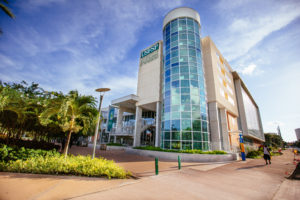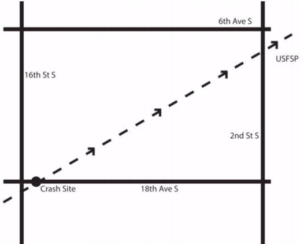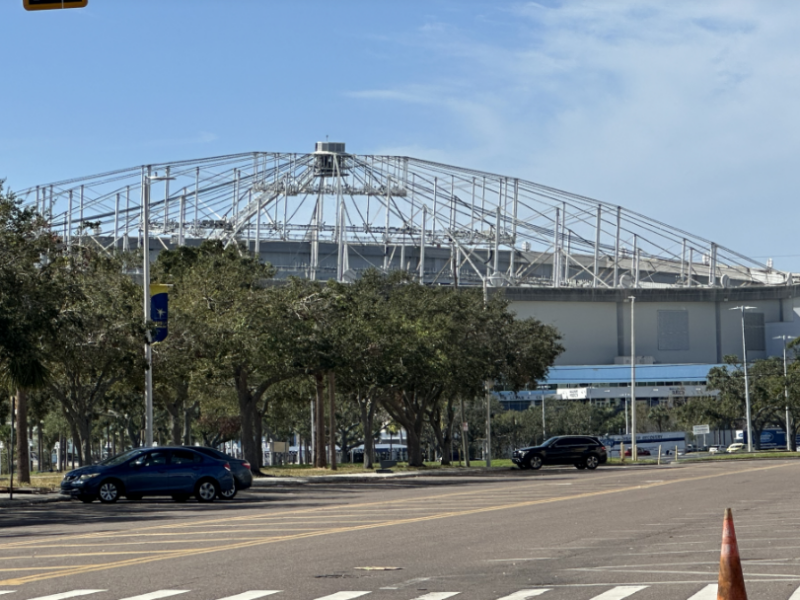By Devin Rodriguez, Whitney Elfstrom and Timothy Fanning
A small plane approaching Albert Whitted Airport made an emergency landing last Wednesday on a busy street 1.5 miles southwest of the university. Miraculously, no one was seriously injured.
But what if the Cessna 402B had come down a few moments later, when the plane was about to pass over the campus?
Virtually no one The Crow’s Nest interviewed later – university administrators, students, city officials – seemed especially worried about the possibility of a crash on a campus where several buildings lie directly beneath the flight pattern of the airport’s main runway.
Frank Biafora, the dean of the College of Arts and Sciences for nearly a decade, said he has grown used to the roar of aircraft engines.
“Airplane crashes are a fact of life,” he said. “We have airports across counties and in big cities. And I don’t have an issue with planes taking off or landing (nearby). I have been here 10 years, and so far as I know there have been no problems.”

There have been at least five fatal accidents involving planes taking off and landing at the small municipal airport since 1987, including a midair collision over Tampa Bay a mile east of Albert Whitted that year that killed both pilots and a passenger.
Four crashes in the last 22 years seem to underscore the potential peril for the USFSP campus and its neighbors, which include two hospitals:
** On April 8, 1995, a Piper Cherokee approaching the airport crashed in a neighborhood a half mile southwest of the campus. It struck the roof of a vacant house at 645 15th Ave. S before crumpling into the side yard. The pilot and his passenger were killed. No one in the neighborhood was injured.
** On Nov. 27, 1996, the pilot of a Lake LA-4 made a mayday call about four miles north of the airport. Moments later, the plane crashed into a church yard, seriously injuring the pilot.
** On Aug. 1, 2012, one man died and another was injured when their Luscombe Silvaire nose-dived into the main runway shortly after taking off. The plane came to rest about 100 feet from the fence at the west end of the runway, just across First Street S from the university.
** On Sept. 15, 2014, a Piper Cherokee apparently ran out of gas while approaching Albert Whitted from the north. It narrowly missed hitting a condominium tower, struck some trees and crashed into Vinoy Park, less than a mile from the airport and the campus.
All four people in the plane were injured, two seriously, according to St. Petersburg police. But it could have been much worse, spokeswoman Yolanda Fernandez said.
“This is a park that’s used by many people every day,” she told the Tampa Tribune. “We have bikers and walkers and families out here, and the fact that it (the plane) was able to land, the four people survived, and it did not injure anybody on the ground is really remarkable.”
Three days after that close call, a Tampa Bay Times editorial called it “a sobering reminder” that city officials needed to reconsider how the airport fits in plans for “the downtown waterfront’s future.”
“As the number and height of buildings in the booming downtown increase and more people live and work there, it makes sense to study and resolve potential safety risks to the public from airport operations,” said the Times, which for decades has called for closure of the airport.
A downtown fixture
The municipal airport has been a fixture on the downtown waterfront since 1929.
In the 1930s, one of America’s first airline companies, National Airlines, was based there, and so was one of the famous blimps of the Goodyear Tire and Rubber Co.
A U.S. Coast Guard air station was added to the airport in 1935, and there was a small pilot training facility there during World War II.
Over time, Albert Whitted began attracting complaints and critics, none louder than the Times, which has repeatedly called the tiny airport a danger and nuisance and contended that its 110 acres are better suited for public use.
Some officials at USF St. Petersburg have also quietly groused about the airport.
Because part of the campus lies directly beneath the flight path of the airport’s main runway, several important buildings – Davis, Bayboro and Coquina halls and the Science and Technology building – can be only two stories high.
But every attempt to close or shrink the airport has failed.
In November 2003, St. Petersburg voters overwhelmingly approved a charter amendment to preserve Albert Whitted and defeated a proposal to replace it with a waterfront park.
The day after the vote, then-Mayor Rick Baker abandoned a compromise plan that would have closed the main runway and allowed the city to sell the remaining land for development.
Both Baker and supporters of the waterfront park proposal had suggested turning part of the airport property into an expansion of USFSP.
Wednesday’s emergency landing
Authorities who are investigating Wednesday’s emergency landing have not announced what caused the pilot to land his charter plane on 18th Avenue S near the intersection with 16th Street at about 3:45 p.m.
But Fire Rescue Lt. Steve Lawrence praised the pilot for putting down on the four-lane street instead of crashing into a building.
He noted what he called “the potential of picking this roadway versus other roadways, or the fact that he didn’t crash into a structure, killing or injuring somebody inside the structure.”
As the plane descended, it hit trees and power lines on the south side of 18th Avenue before rolling into SUVs driven by Alphonsine Dean, 63, and Kimberley Grooms, 34. Grooms was later transported to Bayfront Health St. Petersburg.
“It could have been a lot worse,” Dean told the Tampa Bay Times. “That street is normally busy at that time of day with people picking up their kids from school.”
Both the pilot, Manuel Izquierdo, 36, and his passenger, Ronald Bizick, 50, were treated and released from Bayfront Health.
It was not immediately clear what prompted Izquierdo to land on the busy street. The Federal Aviation Administration is investigating, and the National Transportation Safety Board will determine the probable cause, according to FAA communications manager Kathleen Bergsen.
It could take up to a year to complete the investigation, Bergsen said.
No cause for concern
Richard Lesniak, the manager at Albert Whitted, said the airport presents no danger to the surrounding area.
“If you look statistically at aircraft crashes, they are an extremely rare event,” Lesniak said. “I think it’s less than 2,000 crashes a year. When you’re talking less than 2,000, that’s really low. I mean, one accident is one too many but it’s a very low occurrence.”
St. Petersburg Police Chief Anthony Holloway said his department doesn’t see a need to be concerned about the safety of the area around the airport.
“We look at every incident that happens,” said Holloway. There are a lot of automobile crashes every year in the city, he said, “so we look at them to see what the pattern is. We’ll be talking to our partners at the airport to see if there is some type of pattern with airplane crashes to see what we can do to help in that.”
His comments were echoed by two members of the St. Petersburg City Council.
Charlie Gerdes, whose district covers west and northwest St. Petersburg, said he knows how low planes fly over the university, but he doesn’t think the airport poses a threat.
“If I put myself in the shoes of the students, I can see the planes roaring overhead, and seeing the news about planes running out of gas or having mechanical failures, and the risk of hitting my classroom,” said Gerdes. “That’s a perfectly reasonable question. But I don’t think the risk is reasonable or extraordinary.”
Gerdes cited the strong support the airport got in the 2003 referendum, support that his district still seems to share.
“In my district, there seems to be a very strong attachment to Albert Whitted. It’s in the city’s fabric,” he said. “If it was a genuine fear or nuisance of some kind, I think that vote years ago would have been totally different. However, things change and I would not be surprised that (if) in 15 or 20 years from now we will start talking about what to do with the airport. People may change their minds.”
Karl Nurse is the City Council representative for District 6, which covers the university, Albert Whitted and much of downtown.
Nurse said he lives close to the university and knows firsthand how close the planes fly overhead, but he doesn’t see much change in the future.
“We had a referendum … a decade ago and citizens voted overwhelmingly to keep the airport open, so I couldn’t see it closing anytime soon,” Nurse said.
Nurse said he doesn’t think that the airport poses a significant danger to the university, but he does acknowledge that a problem could arise.
“Inherently, smaller planes piloted by amateur drivers are less safe than the larger commercial aircrafts,” he said.
The city is studying the possibility of extending the main runway at Albert Whitted a quarter mile to the east. That would mean the planes that buzz the campus would be higher and quieter.
But neither Nurse nor Gerdes seemed inclined to support that proposal, which would take a decade, cost at least $12.5 million and need to clear a host of environmental hurdles.
Nurse said the proposed runway extension would be too costly and the environmental hurdles too high.
He said a much smaller expansion – about 300 feet to the east – would be a smarter choice. “With that, I’d think we’d see noticeable improvements,” he said.
Reaction on campus
On campus, where students and faculty have grown accustomed to the sight and sound of planes overhead, some students said they were surprised that a plane had made an emergency landing so close to the university.
“That’s awful that it happened. I go to the airport every Sunday to watch the planes come in,” said Sara Veugeler a junior mass communications major. “It’s terrifying that I never take that into consideration. When I think of school, I think of safe, and school doesn’t have control over air traffic.”

But Student Government President David Thompson noted that USFSP has been here since 1965 “and I haven’t heard of any one (crash) directly impacting our campus. I trust our administrators that if we were in danger of a crash that they would address it.”
Joe Pack, 48, a history major and peer counselor at the university’s Military and Veterans Success Center, was a military policeman who responded to crash scenes at Air Force bases around the world.
Pilots who are about to crash know to hit the street rather than crashing into a building, he said.
“We are right in the path of the (main) runway, so there is a concern,” he said. “But by having an awareness of the possibility of it (a crash) happening and being prepared to put out small gas fires, we would prevent a lot of people from getting hurt.”
“Gas is more dangerous than the plane crash itself because those (small) private planes (at the airport) generally don’t do much damage.
“They’re made of light aluminum,” Pack said. “After a crash, a fuel cell could rupture and leak aviation-rated gasoline. That’s dangerous, but you’re not looking at a massive casualty. We have fire extinguishers all over campus, and as long as we keep faculty and students trained on them, we are good.”
Interim Regional Chancellor Martin Tadlock, who arrived at the university 15 months ago, said he has not been here “long enough to develop these concerns” about airplane mishaps. “I wasn’t here” when there were earlier incidents, he said.
“With these buildings I think a plane could probably slam into Davis Hall and not hurt anybody,” Tadlock said. “They’re built with concrete I mean just look at them, they’re built to withstand mother nature. They’re solid.”
“A crisis can come from anywhere, not necessarily just the airport,” Tadlock said, and the university has emergency plans for any crisis.
If a crash were to occur on campus, the University Police Department would be the first to respond, and Police Chief David Hendry said his staff is prepared.
“From our standpoint as law enforcement, we are prepared for all different kinds of emergencies that occur on campus,” Hendry said. “Being in a downtown setting we can face all different kinds of dangers, but we prepare for eventualities or any kinds of hazards that might confront the campus. That’s our role to prepare and respond.”
According to Hendry, his department does not have specific training for airplane crashes, but it would be the first to establish control on the scene.
“Hypothetically, if a plane were to head to campus, and there were enough time, this is what would happen. The approaching plane would coordinate with air traffic control,” Hendry said. “Then, police, fire and EMS would immediately be notified. The university would be notified, if needed.
“If an incident were to occur, we would likely know about it before it happened.”
Information from the National Transportation Safety Board, the Aircraft Owners and Pilots Association and the Tampa Bay Times was used in this report.
Pictured Above: Fire Rescue Lt. Steve Lawrence praised the pilot for not crashing into a structure, killing or injuring someone inside. Devin Rodriguez | The Crow’s Nest



